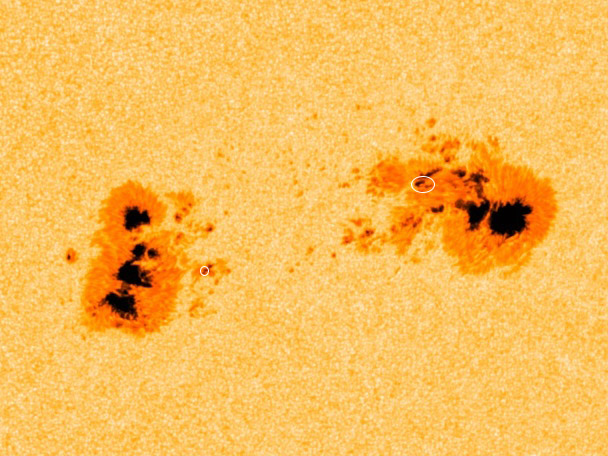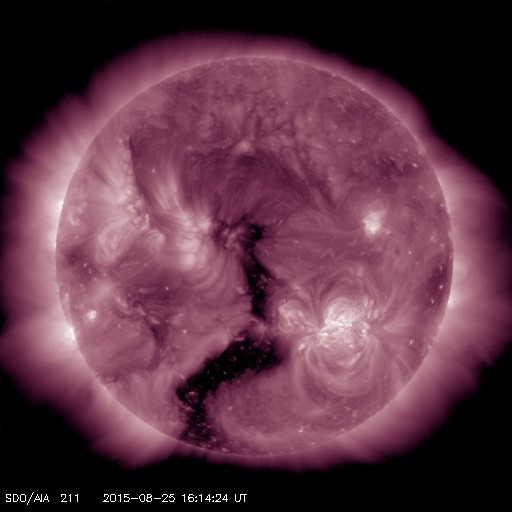Sunspot region 2403, coronal hole facing Earth
Tuesday, 25 August 2015 16:38 UTC

Sunspot region 2403 has been relatively quiet today, the strongest solar flare thus far today has been a C4.3 event at 06:31 UTC. Can we explain the lack of any stronger solar flares?
Yes we can. We unfortunately have to conclude that sunspot region 2403 has stopped growing and showed minor signs of decay during the past 24 hours. There are only two very small delta structures left (indicated with circles) but they are almost not even worth mentioning at this point. Sunspot region 2403 remains a large sunspot region but the magnetic complexity is just not there at the moment for strong (R2+) solar flares. Low-level M-class events (R1) remain possible but the chances are not as high anymore as they were the past few days, mainly because this sunspot region is losing magnetic complexity. A surprise growth spurt is needed if we want to see a fitting farewell blast. We also need to note that this sunpot region is now rotating towards the west limb. What that means is that as time passes by, any eruption from this area will be become less geo effective and could miss Earth.
M-class flare probability for the coming 24 hours: 40% chance
X-class flare probability for the coming 24 hours: 5% chance
Image: Sunspot region 2403 as seen by SDO in visible light. Two delta structures are indicated with circles.
Coronal hole facing Earth
A coronal hole stretching from the Sun's south pole all the way to the equator is now facing Earth. Solar wind flowing from this coronal hole could arrive Friday (August 28) and cause a minor G1 geomagnetic storm.
Image: The Sun as seen by SDO in the 211 Angstrom wavelength where the coronal hole can be seen as the dark area stretching from the south pole all the way to the equator.
Thank you for reading this article! Did you have any trouble with the technical terms used in this article? Our help section is the place to be where you can find in-depth articles, a FAQ and a list with common abbreviations. Still puzzled? Just post on our forum where we will help you the best we can!
Latest news
Latest forum messages
Support SpaceWeatherLive.com!
A lot of people come to SpaceWeatherLive to follow the Sun's activity or if there is aurora to be seen, but with more traffic comes higher server costs. Consider a donation if you enjoy SpaceWeatherLive so we can keep the website online!

Latest alerts
01:45 UTC - Geomagnetic activity
Minor G1 geomagnetic storm (Kp5) Threshold Reached: 01:30 UTC
Tuesday, 15 April 2025
22:30 UTC - Geomagnetic activity
Moderate G2 geomagnetic storm (Kp6) Threshold Reached: 22:23 UTC
22:15 UTC - Geomagnetic activity
Minor G1 geomagnetic storm (Kp5) Threshold Reached: 22:00 UTC
20:00 UTC - Geomagnetic activity
Moderate G2 geomagnetic storm (Kp6) Threshold Reached: 19:44 UTC
19:15 UTC - Geomagnetic activity
Minor G1 geomagnetic storm (Kp5) Threshold Reached: 18:59 UTC
Space weather facts
| Last X-flare | 2025/03/28 | X1.1 |
| Last M-flare | 2025/04/15 | M1.2 |
| Last geomagnetic storm | 2025/04/15 | Kp6+ (G2) |
| Spotless days | |
|---|---|
| Last spotless day | 2022/06/08 |
| Monthly mean Sunspot Number | |
|---|---|
| March 2025 | 134.2 -20.4 |
| April 2025 | 124.1 -10.1 |
| Last 30 days | 124.7 -16.6 |









